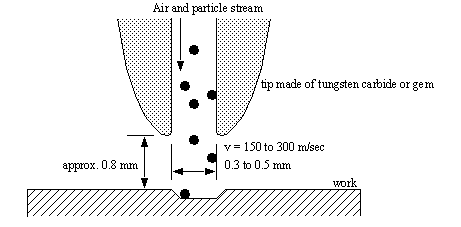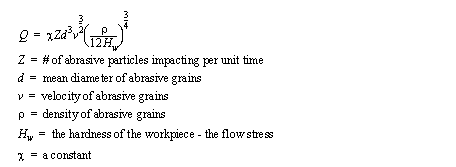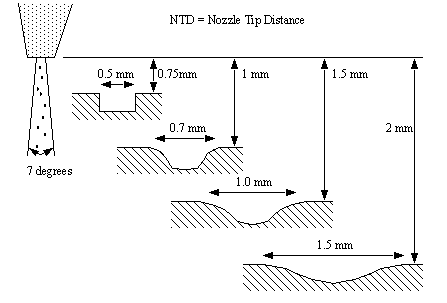
1. Fine particles (0.025mm) are accelerated in a gas stream (commonly air at a few times atmospheric pressure).
2. The particles are directed towards the focus of machining (less than 1mm from the tip).
3. As the particles impact the surface, they fracture off other particles.

• As the particle impacts the surface, it causes a small fracture, and the gas stream carries both the abrasive particles and the fractured (wear) particles away.
• Brittle and fragile work pieces work better.
• Material Removal Rate (mrr) is,

• Factors that effect the process are,
- roughness of surface produced
• The factors are in turn effected by,
- the abrasive: composition; strength; size; mass flow rate
- the gas composition, pressure and velocity
- the nozzle: geometry; material; distance to work; inclination to work
- materials: aluminum oxide (preferred); silicon carbide
- the grains should have sharp edges
- material diameters of 10-50 micro m 15-20 is optimal
- should not be reused as the sharp edges are worn down and smaller particles can clog nozzle.
- mass flow rate of abrasive is proportional to gas pressure and gas flow

- pressure is typically 0.2 N/mm2 to 1N/mm2
- gas composition effects pressure flow relationship
- must be hard material to reduce wear by abrasives: WC (lasts 12 to 30 hr); sapphire (lasts 300 hr)
- cross sectional area of orifice is 0.05-0.2 mm2
- orifice can be round or rectangular
- head can be straight, or at a right angle

• The relationship between head, and nozzle tip distance.

• Air drag also slows abrasive stream.


• Summary of AJM characteristics
- Mechanics of material removal - brittle fracture by impinging abrasive grains at high speed
- abrasives: Al2O3, SiC, 0.025mm diameter, 2-20g/min, non-recirculating
- nozzle - WC, sapphire, orifice area 0.05-0.2 mm2, life 12-300 hr., nozzle tip distance 0.25-75 mm
- critical parameters - abrasive flow rate and velocity, nozzle tip distance from work surface, abrasive grain size and jet inclination
- materials application - hard and brittle metals, alloys, and nonmetallic materials (e.g., germanium, silicon, glass, ceramics, and mica) Specially suitable for thin sections
- shape (job) application - drilling, cutting, deburring, etching, cleaning
- limitations - low metal removal rate (40 mg/min, 15 mm3/min), embedding of abrasive in workpiece, tapering of drilled holes, possibility of stray abrasive action.